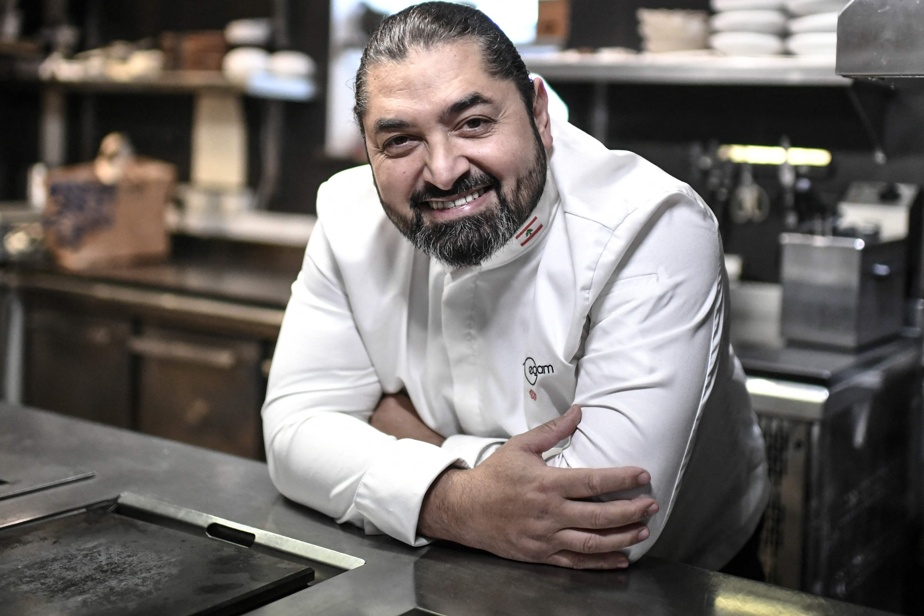(Paris) “My mom doesn’t agree with what I do here: at home, we don’t eat like that,” laughs Alan Geaam, the first and only starred Lebanese chef in his gourmet restaurant in Paris.
This autodidact, who fled the civil war in Lebanon in 1999, believes that to promote the culinary culture of his country, recipes must evolve towards “the elegance and refinement” of French cuisine.
Like him, Greek, Brazilian or Mexican starred chefs based in Paris put French know-how at the service of the cuisines of their childhood, to which clichés stick (basic, too greasy, too spicy, etc.), even if it means attracting reprobation. purists.
When Enrique Casarrubias, the son of a butcher who sold tacos in a market in Mexico before being trained in France in gastronomic establishments, opens his own restaurant Oxte, his Mexican colleagues hardly believe it: “you go straight into the wall “.
“I wanted to show a different Mexican cuisine,” as Mexican fast food was becoming fashionable, Michelin star Enrique Casarrubias told AFP.
Sweet-salty, acidity, bitterness, pepper “flavor enhancer, but which does not burn the tongue”: these tastes that one finds on his plates come from his childhood memories.
“Mexican Trou Normand—fresh fruit with lemon juice, salt, and chilli—I used to eat that when I got out of school. I added mezcal when I was growing up.”
He declines the mole, sauce based on chilli and chocolate, around beets, carrots or in a green version (green tomatoes, jalapeño, pumpkin seeds, cocoa, cinnamon, coriander, parsley).
“I will search until I find the taste of my childhood,” even though “it’s not a cuisine that really exists in Mexico,” he notes.
“You can’t get a Michelin star with traditional Lebanese cuisine,” Alan Geaam told AFP.
Tabbouleh in three textures, including in the form of a water sphere, trompe-l’oeil peanuts made from foie gras or light baklava with seasonal fruits: he dresses his memories with French culinary techniques.
“Tabouleh has been made for 1000 years, no one has touched it. Today, this kitchen needs youth,” says Alan Geaam.
Crowned with a Michelin macaroon since 2018, he has built a real Lebanese gastronomic district in the Marais district of Paris with bistros serving galettes, shawarma or Lebanese pizzas, and is preparing to open his first ephemeral table abroad, in a palace in Switzerland.
Raphaël Rego cooks in his restaurant Oka, 1 star, with Brazilian products… grown in France or from the Amazon to reveal little-known facets of Brazilian cuisine.
“At first, the Brazilians didn’t understand. Today, the star gives me the necessary visibility” for this multicultural project uniting producers, underlines the chef, who is preparing a festival of Brazilian gastronomy in Paris.
His bouillabaisse-style moqueca (fish stew) is proof that gastronomic power does not lie in set recipes.
“Where does the moqueca come from? Some say of Vitoria, others of Bahia. I’m going to use a French saffron condiment, milk and coconut, seasonal vegetables, seafood… And people end up in both Vitoria and Salvador, the capital of Bahia.
Philip Chronopoulos, Greek chef at the Royal Palace, for a long time refrained from falling into caricature by drawing on his origins.
It was during COVID-19 that he reviewed his table, introducing strong Greek markers — bread dipped in olive oil, feta (in ice cream), tarama (with foie gras), spanakopita (herb and feta pie seasoned with Jura yellow wine).
It is with this menu that he will receive his second Michelin star in 2022.
“I would love to go even more Greek on my plates,” he says. A difficult bet, especially in winter, for this “sun kitchen” which “doesn’t have that many specialties”.















